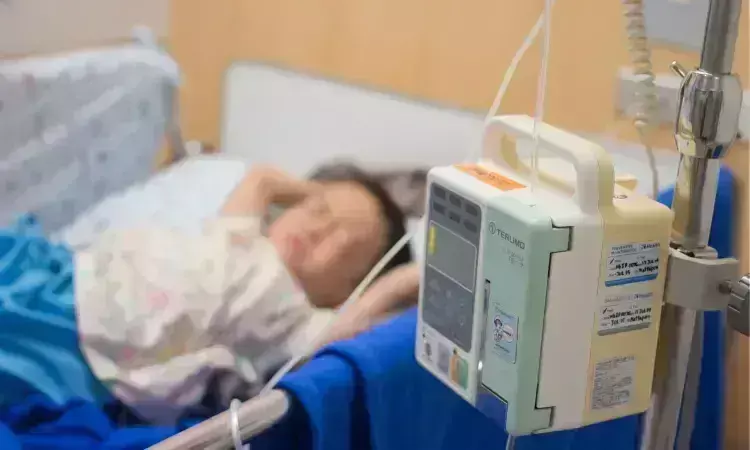- Home
- Medical news & Guidelines
- Anesthesiology
- Cardiology and CTVS
- Critical Care
- Dentistry
- Dermatology
- Diabetes and Endocrinology
- ENT
- Gastroenterology
- Medicine
- Nephrology
- Neurology
- Obstretics-Gynaecology
- Oncology
- Ophthalmology
- Orthopaedics
- Pediatrics-Neonatology
- Psychiatry
- Pulmonology
- Radiology
- Surgery
- Urology
- Laboratory Medicine
- Diet
- Nursing
- Paramedical
- Physiotherapy
- Health news
- Fact Check
- Bone Health Fact Check
- Brain Health Fact Check
- Cancer Related Fact Check
- Child Care Fact Check
- Dental and oral health fact check
- Diabetes and metabolic health fact check
- Diet and Nutrition Fact Check
- Eye and ENT Care Fact Check
- Fitness fact check
- Gut health fact check
- Heart health fact check
- Kidney health fact check
- Medical education fact check
- Men's health fact check
- Respiratory fact check
- Skin and hair care fact check
- Vaccine and Immunization fact check
- Women's health fact check
- AYUSH
- State News
- Andaman and Nicobar Islands
- Andhra Pradesh
- Arunachal Pradesh
- Assam
- Bihar
- Chandigarh
- Chattisgarh
- Dadra and Nagar Haveli
- Daman and Diu
- Delhi
- Goa
- Gujarat
- Haryana
- Himachal Pradesh
- Jammu & Kashmir
- Jharkhand
- Karnataka
- Kerala
- Ladakh
- Lakshadweep
- Madhya Pradesh
- Maharashtra
- Manipur
- Meghalaya
- Mizoram
- Nagaland
- Odisha
- Puducherry
- Punjab
- Rajasthan
- Sikkim
- Tamil Nadu
- Telangana
- Tripura
- Uttar Pradesh
- Uttrakhand
- West Bengal
- Medical Education
- Industry
Solar-powered oxygen efficacious and cost-effective means of supplying oxygen in rural settings:Lancet

Solar-powered oxygen efficacious and cost-effective means of supplying oxygen in rural settings suggests a new study published in the Lancet.
Supplemental O2 is not always available at health facilities in low-income and middle-income countries (LMICs). Solar-powered O2 delivery can overcome gaps in O2 access, generating O2 independent of grid electricity. We hypothesized that installation of solar-powered O2 systems on the paediatrics ward of rural Ugandan hospitals would lead to a reduction in mortality among hypoxaemic children. In this pragmatic, country-wide, stepped-wedge, cluster randomised controlled trial, solar-powered O2 systems (ie, photovoltaic cells, battery bank, and O2 concentrator) were sequentially installed at 20 rural health facilities in Uganda. Sites were selected for inclusion based on the following criteria: District Hospital or Health Centre IV with paediatric inpatient services; supplemental O2 on the paediatric ward was not available or was unreliable; and adequate space to install solar panels, a battery bank, and electrical wiring. Allocation concealment was achieved for sites up to 2 weeks before installation, but the study was not masked overall.
Children younger than 5 years admitted to hospital with hypoxaemia and respiratory signs were included. The primary outcome was mortality within 48 h of detection of hypoxaemia. The statistical analysis used a linear mixed effects logistic regression model accounting for cluster as random effect and calendar time as fixed effect. Findings: Between June 28, 2019, and Nov 30, 2021, 2409 children were enrolled across 20 hospitals and, after exclusions, 2405 children were analysed. 964 children were enrolled before site randomisation and 1441 children were enrolled after site randomisation (intention to treat). There were 104 deaths, 91 of which occurred within 48 h of detection of hypoxaemia. The 48 h mortality was 49 (5·1%) of 964 children before randomisation and 42 (2·9%) of 1440 (one individual did not have vital status documented at 48 h) after randomisation (adjusted odds ratio 0·50, 95% CI 0·27-0·91, p=0·023). Results were sensitive to alternative parameterisations of the secular trend.
There was a relative risk reduction of 48·7% (95% CI 8·5-71·5), and a number needed to treat with solar-powered O2 of 45 (95% CI 28-230) to save one life. Use of O2 increased from 484 (50·2%) of 964 children before randomisation to 1424 (98·8%) of 1441 children after randomisation (p<0·0001). Adverse events were similar before and after randomisation and were not considered to be related to the intervention. The estimated cost-effectiveness was US$25 (6-505) per disability-adjusted life-year saved. This stepped-wedge, cluster randomised controlled trial shows the mortality benefit of improving O2 access with solar-powered O2. This study could serve as a model for scale-up of solar-powered O2 as one solution to O2 insecurity in LMICs.
Reference:
Conradi N, Opoka RO, Mian Q, Conroy AL, Hermann LL, Charles O, Amone J, Nabwire J, Lee BE, Saleh A, Mandhane P, Namasopo S, Hawkes MT. Solar-powered O2 delivery for the treatment of children with hypoxaemia in Uganda: a stepped-wedge, cluster randomised controlled trial. Lancet. 2024 Feb 24;403(10428):756-765. doi: 10.1016/S0140-6736(23)02502-3. Epub 2024 Feb 14. PMID: 38367643.
Dr. Shravani Dali has completed her BDS from Pravara institute of medical sciences, loni. Following which she extensively worked in the healthcare sector for 2+ years. She has been actively involved in writing blogs in field of health and wellness. Currently she is pursuing her Masters of public health-health administration from Tata institute of social sciences. She can be contacted at editorial@medicaldialogues.in.
Dr Kamal Kant Kohli-MBBS, DTCD- a chest specialist with more than 30 years of practice and a flair for writing clinical articles, Dr Kamal Kant Kohli joined Medical Dialogues as a Chief Editor of Medical News. Besides writing articles, as an editor, he proofreads and verifies all the medical content published on Medical Dialogues including those coming from journals, studies,medical conferences,guidelines etc. Email: drkohli@medicaldialogues.in. Contact no. 011-43720751


